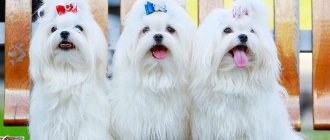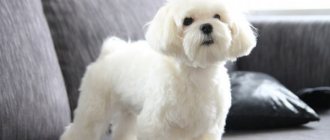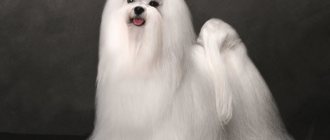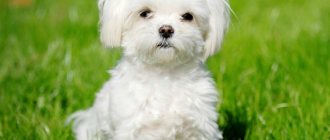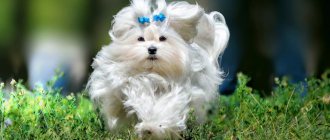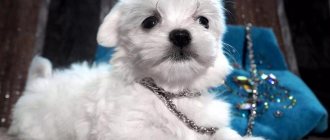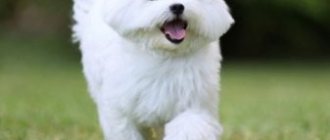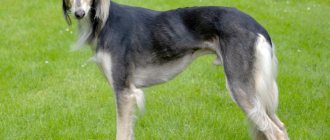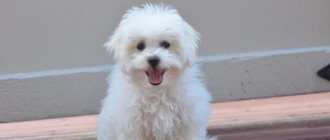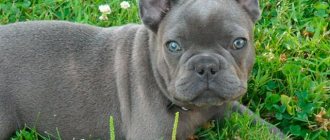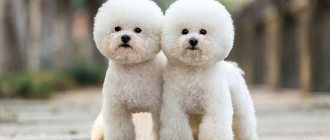Maltese dogs are miniature lap dogs with expressive, curious dark eyes, a slightly elongated body and long snow-white hair. Smart and observant little ones adapt well to the rhythm of life of their owners, but with excessive connivance they easily turn into spoiled and jealous creatures.
Let's find out what Maltese dogs are and how to make life together comfortable for both owners and their pets.
Brief history of origin
Maltese appeared so long ago that it is simply unrealistic to establish its exact origin. Finding out the history of the breed is also hampered by the fact that there are other varieties of lapdogs on the planet, each of which claims to be the oldest.
It is assumed that the name Maltese comes from the name of the island of Melita, where they lived 2000 years ago. But since the ancient Romans and Greeks called various islands in the Mediterranean Sea by this name, history again came to a standstill.
Aristotle contains references to “Meletian dogs,” which were later renamed Maltese and associated with Malta. Those ancient lapdogs may turn out to be the ancestors of modern dogs, in the formation of which small spaniels and toy poodles participated. They were popular among the Roman nobility. And merchants presented them as diplomatic gifts.
In England, they learned about Maltese dogs in the first half of the 16th century, and in the USA the dog was registered in 1888 and began to be used as a source breed for breeding American lines.
The Maltese received FCI recognition in 1955 and was classified in the Toy and Companion Dogs group of the Bichon subsection.
History of the Russian Tsvetnaya Bolonka breed
A clan of Russian colored lapdogs began to form in Leningrad after the end of the Great Patriotic War.
If after the revolution, decorative breeds aroused hostility among Soviet breeders, as a living reminder of the hated aristocracy, then by the middle of the 20th century, pre-war stereotypes had lost their relevance. In addition, the interest of Leningraders in miniature dogs had a practical orientation. At that time, the majority of Soviet citizens lived in communal apartments and the memories of the blockade were still fresh. And small pets fit perfectly into the conditions of limited space, moreover, it was easier to feed them than, for example, a shepherd dog or a Great Dane. Leningrad breeders presented the first pair of colored lapdogs in 1951. These were individuals of black and brown colors. Formally, it is believed that the ancestors of the RCB were decorative mixed-breed dogs, which were brought to Leningrad from all over the Soviet Union and then crossed with each other. According to dog breeders of that time, Russian colored lapdogs managed to combine the genes of such breeds as Shih Tzu, Lhasa Apso, and Maltese. As for the appearance standard, it was approved for flowerlings in 1966, although registration of litters in stud books was carried out back in the late 50s.
Until the early 70s of the 20th century, the main population of the breed lived in Leningrad and only a few Moscow breeders could boast of keeping Russian colored lapdogs. In the 90s, the former and current capitals swapped places: while in St. Petersburg the demand for decorative fluffies fell, they were at the peak of popularity among Muscovites. Taking advantage of the newly flared fashion for mini-pets, Moscow enthusiasts immediately opened several large RCB nurseries, from which more than one generation of healthy and spectacular lap dogs emerged.
In 1999, the National Club of Russian Colored Lapdogs began its work under the RKF. And on the eve of the new millennium, dog breeders in the Northern capital once again remembered the breed. The result of this interest was the registration of large single-breed nurseries in St. Petersburg, puppies from which were sold not only to domestic buyers, but also abroad. For example, in the late 90s, RCBs began to “emigrate” to the USA, Canada, Norway, Sweden and Finland.
Video: Russian colored lapdog
Interesting Facts
Over the centuries-old history of Maltese dogs, a lot of interesting things have happened to them:
- According to one version, the name of the breed comes not from the name of the Mediterranean island, but from the Latin word malat - “harbour”. This assumption arose due to the fact that Maltese originally traveled with sailors and were a threat to ship rats.
- There is a possibility that Maltese dogs took part in the formation of the Pekingese.
- Dogs of this breed have been the muses of many famous artists. Images of the Maltese are found in paintings by Rubens and Goya.
- Maltese dogs were the favorites of many crowned heads. Tiny snow-white dogs lived at the court of the French king Louis IX, the Spanish ruler Philip II, the English Queen Elizabeth I and Empress Catherine II.
Breed description, standards, appearance
The Maltese is a proportional, harmoniously built dog with an elegant body and aristocratic posture. The first breed standard appeared in 1955; the 2015 edition is now valid.
According to this document, the purebred Maltese has the following characteristics:
- The head is wide, with a flat skull, a short muzzle, an almost invisible central groove, a convex crown and a pronounced stop. The nose is voluminous, with open nostrils and a rounded black nose. The jaws are strong, with a full set of white teeth. Scissor bite. The lips are dense and black. The upper one slightly covers the lower one and has the shape of a semicircle.
- The eyes are large, round, slightly protruding. The iris is dark ocher in color. The eyelids are tight-fitting and black.
- The ears are hanging, triangular, wide at the base, set high, fitting well to the muzzle. The outer part of the canvas is covered with thick, long hair.
- The body is moderately elongated, with unpronounced withers, level loin, deep chest and slightly curved ribs. The neck is almost vertical. The croup is wide, with a slight slope at the base of the tail.
- Limbs are straight. Elbows set straight, tightly pressed to the body. Pasterns are strong, almost vertical. The thighs are muscular, slightly inclined forward. The feet are round, well furred, with black pads and arched toes.
- The tail is gracefully curved, the tip touching the back or slightly tilted to the side.
On a note. Sometimes Maltese dogs give birth to puppies with extremely shortened muzzles. Such individuals are not allowed for exhibitions and breeding activities, but they are very photogenic and are in demand among ordinary owners.
The breed standard also contains a list of defects, the presence of which will disqualify the dog:
- narrowed or diverging lines of the skull;
- unpigmented eyelids;
- short or absent tail;
- Roman nose;
- incorrect bite;
- polydactyly;
- cryptorchidism.
Size and constitution
Maltese dogs are miniature dogs with poor sexual dimorphism. Depending on the size, there are 2 intra-breed varieties:
- Classic (Italian). It is focused on FCI standards and is considered the largest of all. The weight of a classic type Maltese is 3-4 kg, and its height varies between 20-25 cm.
- American. The appearance of these Maltese is regulated by the standard of the American Kennel Union. These lap dogs are smaller than the classic type and weigh up to 2.7 kg.
There is also a mini Maltese, whose weight is only 1.5-2.5 kg and height does not exceed 20 cm. Externally, such a dog is closer to representatives of the American type and does not meet the FCI standard. Therefore, the Micro Maltese is not allowed in exhibitions organized by the Fédération Cynologique Internationale.
Color and coat type
The Maltese breed belongs to the long-haired category. Its representatives are covered with light, straight hair, under which lies a poorly developed down. It is quite thick and has a silky texture. The Maltese's coat flows like a mantle and clearly outlines the contours of the dog's body.
Its minimum length should be 20 cm. The Maltese's tail must have a dewlap that reaches the hocks and forms a lush cascade.
Important! There should be no fuzz or protruding tufts of hair on the body of the Maltese dog. The exception is the inside of the front and hind legs. On these parts of the dog's body, feathering and trousers are acceptable.
According to the standard, the Maltese dog can only have a white color or ivory-colored coat. All other color variations are considered unacceptable.
Health and life expectancy
Maltese were formed with minimal interference from breeders. Therefore, they have good health and good heredity. Maltese dogs live on average 12-15 years and rarely get sick.
The most common health problems for Maltese include the following pathologies:
- dislocation of the kneecap;
- digestive problems;
- hypoglycemia;
- blindness;
- dermatitis;
- tracheal collapse;
- allergy;
- heart disease;
- hydrocephalus;
- deafness;
- ophthalmological diseases.
On a note. The baby-face Minimaltese is weaker than its standard counterparts. Due to the specific structure of the skull and insufficient weight, such dogs are more likely to get sick and injured.
Breed standard Russian Tsvetnaya Bolonka
The exterior of the representatives of the breed is emphatically pretty. Glamorous curly “fur coats”, round cherry eyes and a compact, slightly elongated body – all together this forms a unique type of image pet. The optimal height of today's Russian colored lap dog is 26 cm. Moreover, this figure is desirable for both females and males, although earlier standards indicated sexual dimorphism as a mandatory requirement for the exterior.
Deviations from the growth norm are permissible, but no more than a couple of centimeters - “Gullivers” and “dwarfs” are not allowed for breeding in nurseries. An exemplary flowering plant weighs 3-4 kg. As for the coat, the requirements for it have also undergone changes. If Soviet lap dogs were required to have exclusively curly hair, then for modern individuals a wavy hair structure has become an acceptable option.
Head
The skull is convex, slightly rounded, with prominent apple cheekbones, non-protruding brow ridges and the same occipital protuberance (bump). Short type stop, easy to identify. The muzzles of Russian colored lapdogs are short, dry, with straight backs. The base of the muzzle is quite wide, the tip is slightly narrowed.
Teeth, lips and jaws
Representatives of the breed have wide jaws that form a scissor-type bite in the bow, instead of which a tight overshot and pincer-like (straight) bite are also allowed. Ideal indicators of dental health are their white color, as well as their close arrangement in a row. The lack of fangs or incisors in the jaw is a serious defect in the exterior. The neat thin lips of the animal are pigmented black or to match the color.
Nose
With fairly miniature lobes, the dog’s nostrils are large and wide open. The skin of the nose can be colored to match the coat or have an anthracite-black color.
Eyes
The almost round eyes of Russian colored lapdogs are complemented by straight posture and dark irises. If the animal's fur is brown, a slight lightening of the eye color is allowed. The thick, dry skin of the eyelids is pigmented in coal black or any other shade in accordance with the color. The look of the breed is touchingly friendly, radiating positivity.
Ears
The shape of the lap dog's ears is triangular, with a flattened miniature tip. The characteristic position of the ear is hanging down on the cartilage with a moderately high set.
Neck
The neck, characterized by a high set, is moderately muscled, has dry contours and is of medium length.
Frame
Russian colored lapdogs are compact dogs, but with a fairly wide body. The animal's back gives the impression of being smooth, elongated and muscular, while a slight slope of the topline is noticeable in the segment between the withers and the root of the tail. The convex short loin ends in the croup, which is characterized by moderate sloping and rounded contours. The chest, shaped like a regular oval, is of good length and descends almost to the elbows. RCB's belly is not tucked too high.
Limbs
The main features of the legs of the Russian colored lapdog are parallelism to each other and relatively wide set. The oblique scapulae are the same length as the humerus, creating an articulation angle of 100-110°. Straight forearms are held level, the contours of the wrists fit into the vertical formed by the skeleton of the forearms.
The thighs of the representatives of the breed are not very long, but with quite prominent muscles. The angles of the knee joints are normally expressed, the shins are of normal, not excessive length. The hock joints are strong, dryish, with clear angular joints. The short hocks in the stance are fixed in a vertical position. The lapdog moves at a free, energetic trot.
Tail
The tail, laid on the back or curled into a ring and thrown over the croup, is covered with abundant hair. A prerequisite is that the tip of the tail is always in contact with the dog’s body.
Wool
All individuals have wavy or large curled fur. The hair is long, evenly distributed over the body, with an insignificant or sufficient amount of undercoat. Abundant decorative fur grows on the forehead. Russian colored lapdogs are not cut or trimmed. Hair shortening is possible only on certain areas of the body for hygienic purposes.
Coat colors
Representatives of the breed can have any color, with the exception of white, harlequin and spotted colors. However, subtle white markings on the throat, chest, chin and fingertips are acceptable.
Disqualifying defects in appearance and behavior
- Unreasonable shyness and aggressiveness.
- Missing decorative hair on the forehead.
- Heterochromia of the iris, blue eyes.
- Twisted jaw, underbite.
- Loosely covered lips, visible incisors and fangs.
- Non-standard type of coat color.
- Height over 28 cm.
- Dwarf dimensions.
- Boobtail.
Character and behavior
The Maltese is a perky, friendly dog that can maintain puppy playfulness for a long time. In the family, she singles out one owner, and treats other household members as equals. Maltese loves attention and cannot be left alone for long. From lack of communication with its owners, the dog becomes nervous and acquires bad habits.
The Maltese is confident in its own superiority and gets along well with other pets. A cheerful and mischievous dog regards them as potential play partners, but can compete for the attention of its owners. If the owner pets another animal, the Maltese turns into a jealous fury, ready for meanness.
The Maltese is wary of strangers and perceives them as a potential threat. The dog rushes towards any guest with a loud, menacing bark. Of course, a miniature Maltese cannot cause serious damage, but it will certainly make noise and scare away an intruder.
Breed and children
Judging by the photo of an adult lapdog, it seems that this dog is ideal for families with children. In fact, the Maltese is not the best choice for people with babies. Preschool children can inadvertently injure a tiny dog or provoke it into aggression with their importunity.
The Maltese will easily get along with teenagers and become an ideal companion for walks together.
Character of the Russian colored lapdog
Russian colored lapdogs are tiny keepers of their master's secrets and affectionate companions, ready to share any leisure time with a person, except extreme sports. Funny in appearance and in essence, dogs can become pocket psychotherapists in cases where the background presence of a living creature in the apartment is necessary. In addition, flowers are simply crazy about hugs and affectionate cuddles, which are regarded as well-deserved encouragement. Take a closer look at this breed if you are looking for a pet that will be in a state of permanent euphoria from your stroking and scratching behind the ears.
The breed initially had an image of being spoiled and passive couch dogs. In fact, Russian colored lapdogs are not at all lazy and are ready to spend hours “cleaning” the house, taking your socks and slippers to the most unexpected places. When walking, these tiny curlies also don’t waste time, trying to establish contacts with small and large relatives, as well as planning little adventures to bring all sorts of rodents to a state of stress. By their nature, lapdogs are non-conflict creatures, but only until someone encroaches on their property and the contents of the bowl. As soon as the cup of patience is full, the four-legged darling begins to bark amusingly, using his teeth in the most critical situations.
Despite their official status as a companion breed, flowering cats are absolutely unobtrusive. These shaggy helpers will willingly get involved in the process of preparing dinner by the owner, but without any hysterics they will leave the kitchen as soon as the owner makes it clear that he does not need anyone’s services. In addition, Russian colored lapdogs will definitely gain the trust of your guests and acquaintances, if only because they will not scan them with a suspicious look and try to bite their heels. Animals willingly go into the arms of almost everyone who is part of the family, thus acquiring their own army of fans.
Despondency, depression, frustration are concepts that RCB have never encountered. This breed is by default charged with positivity and fun, which it generously shares with others. Lapdogs also build friendly relationships with children. Even if kids do not behave entirely correctly towards a dog, they are not in danger of being bitten by an unhappy pet. Animals do not suffer from the vindictiveness characteristic of some decorative breeds. In addition, Russian colored lapdogs easily get along with large dogs. True, the point here is not so much the peacefulness of flowering flowers, but their size. Small “tails” are not perceived by wolfhounds and Boerboels as something competitive, so serious friction does not arise between representatives of different weight categories.
How to choose a pet
The Maltese is a popular breed that scammers often want to make money from selling. To avoid getting a sick or purebred dog as a pet, you need to contact professional breeders or registered kennels.
When choosing a Maltese puppy, it is advisable to look at several litters and ask in advance:
- presence of documents and stamps;
- health status;
- conditions of keeping the mother and puppies.
Pedigree Maltese puppies must have:
- dark eyes;
- black nose;
- white color;
- straight, not too fluffy coat.
On a note. Maltese puppies have a slightly wavy coat that will straighten out as they mature. But strong curls are considered a defect and are unlikely to disappear with age.
Before making the final choice, you need to observe the behavior of the Maltese puppy you like. He should be moderately curious, friendly and sociable.
Puppy care
A Maltese puppy from a good nursery moves to a permanent place of residence no earlier than 2.5-3 months. Therefore, future owners have time to prepare. To make the life of a Maltese dog comfortable, purchase for it in advance:
- toys;
- sleeping area;
- harness and leash;
- hygiene products;
- grooming tools;
- bowls for food and water.
For safety reasons, wires, medicines, household chemicals and indoor plants are hidden in the house where the Maltese puppy will live. And to prevent your baby from ruining the carpets, it is better to remove them until he is toilet trained.
After arrival, the puppy is given time to adapt and allowed to become familiar with its new home. The Maltese baby must be shown where he can eat and rest. And so that he does not experience separation from his mother so acutely, a little thing with the smell of his native “nest” is placed on his sleeping place.
When the Maltese puppy gets used to its owners, it is taught to be calm about hygiene procedures and adhere to the rules of behavior.
To prevent the baby from growing up spoiled, he is not allowed to:
- bite;
- beg;
- sleep on upholstered furniture.
So that you can walk with your Maltese puppy and not be afraid that he will get an infection, he is vaccinated. The baby is vaccinated with a complex drug:
- from plague;
- rabies;
- parainfluenza;
- leptospirosis;
- parvo and coronavirus enteritis.
The first vaccination for a Maltese puppy is given at 8-9 weeks and repeated after 21 days. Before this, he is given anthelmintic drugs, the dosage of which is calculated strictly by weight.
It is recommended to carry out antihelminthic treatment of Maltese twice with a break of 10-14 days.
Care and maintenance
The mini and standard Maltese belong to the decorative breeds. She is not suitable for street life. These dogs love comfort and are ideal for home keeping. Caring for a Maltese comes down to regular grooming, proper feeding and timely veterinary care.
Hygiene procedures
In order for the Maltese to have a neat appearance, it is provided with appropriate care:
- The dog's teeth are cleaned 2-3 times a week with a silicone brush and a small amount of special paste. To prevent plaque from appearing on them, your Maltese can be given chewy treats.
- The dog's ears are wiped weekly with a cotton swab dipped in a special lotion. They are also regularly checked for unusual discharge. If any suspicious symptoms appear, the dog is shown to the veterinarian.
- The eyes of the Maltese require special attention. They are wiped daily with a cotton pad moistened with boiled water and inspected. If redness, excessive dryness or increased tearing is detected, the dog is scheduled for a consultation at the clinic.
- As they grow, the Maltese's claws are carefully shortened with a nail clipper so as not to touch living tissue.
- The show dog's coat is washed weekly using a special shampoo and conditioner. Then the Maltese coat is blotted with a towel, dried with a hairdryer and rolled into curlers. If the dog is not a show dog, then it gets a nice haircut.
- Brush your Maltese dog daily. To begin with, carefully sort the dog's fur with your hands and, if necessary, untangle the tangles. Then it is sprinkled with talcum powder and combed with a fine-toothed metal comb. The Maltese's "bangs" are gathered into a ponytail and secured with a hairpin or elastic band.
Feeding
Maltese dogs need adequate nutrition. Dogs of this breed should not be overfed. Otherwise, they begin to gain weight and develop health problems.
The Maltese should be fed strictly on a schedule taking into account its age:
- up to 8 weeks – 5-6 times a day;
- 2-6 months – 4 times a day;
- 6-12 months – 3 times a day;
- over 12 months – 2 times a day.
Industrial feed
Some types of dry food cause allergies in Maltese dogs. Therefore, they are selected individually. Maltese eat well the following brands of dry food:
- Josera;
- Brit Care;
- Hills;
- Grandorf.
Important! When purchasing dry food for Maltese, preference is given to imported super-premium products for miniature breeds or for dogs prone to allergies. It is advisable that it does not contain soy, chicken, dyes, corn, wheat and other dubious additives.
Natural feeding
With this type of diet, half of the Maltese's diet should be lean meat such as rabbit, turkey or lamb. It is not advisable to give chicken and beef to a dwarf dog because they can cause allergies.
In addition to meat, the Maltese dog’s diet must be supplemented with:
- cereals;
- vegetables;
- giblets;
- sea fish;
- fermented milk products.
In order for the Maltese to remain healthy longer, the following will be removed from its menu forever:
- beans;
- spices;
- pork;
- confectionery;
- any food from the master's table.
Walking and exercise
Although the Maltese is an indoor breed that can be trained to use a litter tray or diaper, it needs fresh air. It is better to walk such a dog in warm and dry weather. And in rain or mud, the Maltese can be dressed up in waterproof overalls.
On a note. Maltese dogs get tired quickly from walking, so their duration should not exceed 30 minutes.
Training and education
Maltese dogs do not need special training, but they must know basic commands. These small dogs are quite stubborn and quickly acquire bad habits. Therefore, raising a Maltese needs to be done from an early age.
On a note. To prevent your Maltese puppy from getting tired and losing interest in activities, they should be short and varied.
In order for a Maltese to learn to relate calmly to the world around it, it must be socialized. From an early age, the dog is taught not to react to street noise, strangers, other animals and vehicles.
Education and training
Due to their amusing appearance and compact size, Russian colored lapdogs give the impression of being harmless pets that you won’t have to deal with. However, you can’t do without learning the basics even in the case of such good boys as tsvetnushki. And the point here is not only that, without knowing how to control the dog’s behavior, you take great risks on every walk. An ill-mannered “tail” will come up with a way to annoy you without even leaving the apartment, so don’t be lazy to introduce the animal to discipline and etiquette.
The training of the breed is based on the classical principle: first adaptation and socialization, then education and the final stage – the training itself. An important component of the process is establishing the boundaries of what is permitted and a system of prohibitions. Everything here is exactly the same as in the case of large breeds. If you don’t want your pet to tumble on your bed after a walk, then don’t let him do this the rest of the time. If you don’t want to raise a beggar who begs for tasty morsels from the table, don’t throw him tasty treats during lunch. The main commands, with the help of which it is convenient to control the behavior of the RCB, are “Ugh!”, “You can’t!”, “Come to me!”, “Place!”, “Walk.”
Russian colored lapdog puppies begin to be distributed at two months. This is the optimal age period to help the baby adjust to further independent life. It is necessary to adapt to a new habitat smoothly and not only within the owner’s home, therefore, as soon as the animal has received age-appropriate vaccinations and has served time in quarantine, it must be taken outside. However, it is better to take the first walks in quiet, calm places, and postpone trips along avenues and shops until the time when the dog gets used to new sounds and smells.
It is recommended to carry out initial training for Russian colored lapdog puppies as early as three months. If you bought an older animal, this is not a problem - up to six months, the breed absorbs new knowledge quickly and easily. Acquaintance with a leash and collar also begins at three months of age. Remember that the first use of "limiters" should be short. You shouldn’t turn your first outing on a leash into a half-hour excursion around the neighborhood.
Punishments in the case of Russian colored lapdogs do not work for several reasons, the main one of which is the psychological characteristics of the breed, which force us to regard harsh penalties as an attempt to suppress the will. Therefore, if your ward does something absurd, do not shout or swing your arms. It’s better to try to switch the dog’s attention to another action or object - in the case of puppies and young animals, this method works flawlessly.
Sometimes a light slap with a newspaper on the dog’s loin is allowed, but such “light execution” is used in special cases. For example, when a Russian colored lapdog knows how to use a litter box, but for unknown reasons continues to make puddles on a chair or bed. Otherwise, when training flowerlings, it is more advisable to rely on “gingerbread” methods - the breed has its own food addictions, for the satisfaction of which its representatives will move mountains. It’s also better not to overdo it with prohibitive commands: the requirement “You can’t!” should not be consumed more than 3-4 times a day, otherwise there is a risk of raising a frightened and dependent creature from a lapdog.
Puberty and mating
The first heat in Maltese dogs begins at 6-12 months. But dogs older than 15 months and younger than 9 years are allowed for breeding. To obtain viable offspring, only completely healthy and vaccinated Maltese dogs are used, the exterior of which corresponds to the breed standard.
Mating is carried out in the male's territory and repeated the next day. Before mating, the dogs are not fed and allowed to get to know each other. If everything goes well, then after 58-64 days the Maltese will give birth to healthy puppies.
Health and diseases of Russian colored lapdogs
Paradoxically, little lapdogs are creatures with a strong immune system and good health. The breed does not have many genetically determined ailments, and most of them were inherited from their ancestors, the Havanese Bichons. Diseases that can pass to animals from distant relatives:
- cataract;
- prolapse of the third eyelid gland;
- excessive tearing;
- luxation of the patella;
- hip dysplasia;
- Perthes disease;
- cardiomyopathy;
- hypothyroidism;
- epilepsy;
- allergy;
- deafness;
- skin diseases (hyperkeratosis, adenoma of the sebaceous glands).
Do not panic and try to look for all the listed health problems in your pet. Each dog inherits a unique set of genes and does not always receive a “bonus” of Bichon disease. The best way to protect yourself from purchasing a defective puppy is to choose an interested breeder who has gained sufficient experience and is careful in selecting breeding specimens. The importance of tests for genetic diseases has also not been canceled, so before buying a dog, always find out the results of a medical examination of its parents.
Maltese price
The price of a Maltese depends on many factors and varies widely.
- The most expensive dog is the Maltese dog with show prospects and an elite pedigree. The price of such a puppy can reach 80 thousand rubles.
- A purebred dog with documents but a mediocre exterior costs about 20 thousand rubles.
- Maltese mini or baby face can be bought for 35-45 thousand rubles.
Maltese dogs are adorable dogs with a luxurious white coat that contrasts sharply with their dark eyes and black nose. Good-natured mischief-makers attract admiring glances and will become wonderful companions for those who are not too lazy to care for their luxurious fur coat.
